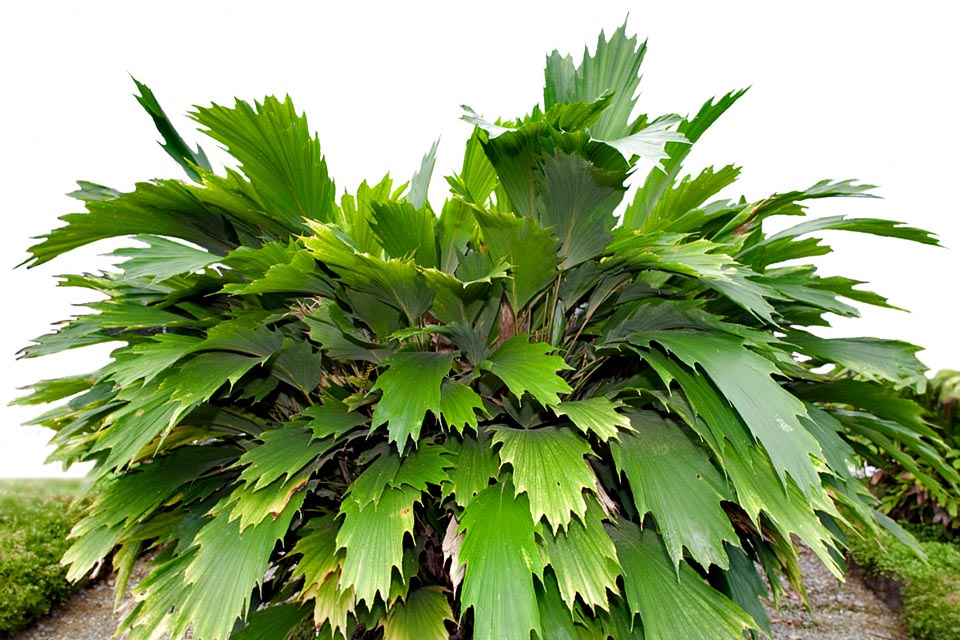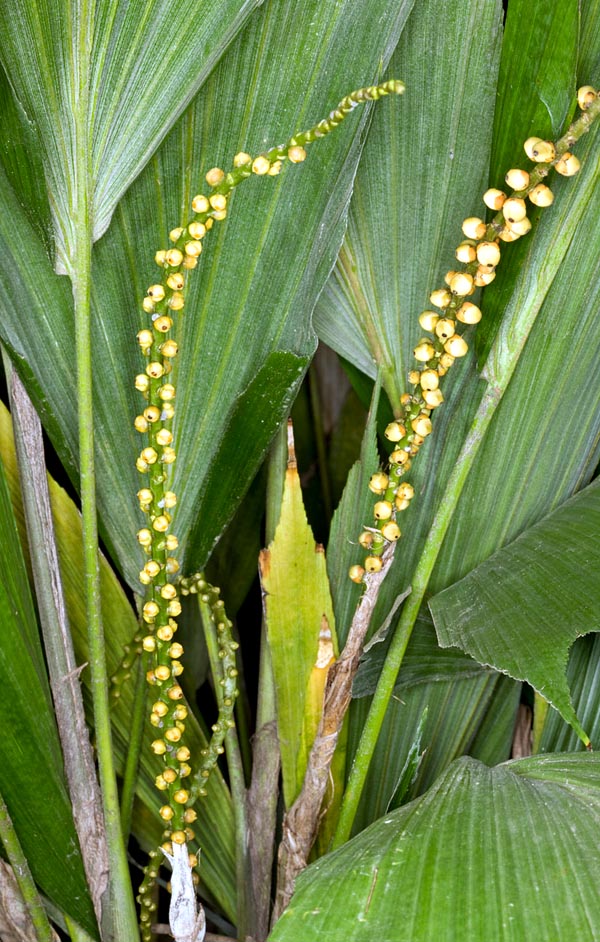Family : Arecaceae

Text © Pietro Puccio

English translation by Mario Beltramini

Native to South-East Asia, Arenga hookeriana is a bushy species, monocarpic with entire very decorative toothed leaves © Giuseppe Mazza
The plant is native to the humid forests of the Malaysian peninsula and the southern Thailand, where it grows up to about 500 m of altitude.
The name of the genus, Arenga, comes from the Malaysian ‘areng’, with reference to the Arenga pinnata. The species is honoured to the English botanist and explorer Joseph Dalton Hooker (1817-1911).
Common names: Hooker’s sugar palm (English); palmeirinha-seta (Portuguese).
Arenga hookeriana (Becc.) Whitmore (1970) is a monoecious plant, monocarpic (bearing fruit only one time during its existence), caespitose with thin stems, 1-2 cm of diameter, tall up to about 3 m and covered by the fibrous residuals of the foliar bases which persist for long time.

The male and female inflorescences of Arenga hookeriana are about 50 cm long and form on the same plant © Giuseppe Mazza
The leaves, long up to 0,8 m and about 0,3 m broad, on an even 0,5 m long petiole, are usually undivided, oblong with indented and lobed margins and sharp apices, of pale green colour on the upper page, green-grey on the lower one; they are rarely pinnate with few linear to rhomboidal pinnulae with elongated apex.
The inflorescences develop between the leaves, slanting upward at the beginning, then curving, about 0,5 m long, usually simple, rarely ramified, carrying only male or female flowers, but always on the same plant, with the inflorescences with female flowers developing before the male ones.
The fruits are ellipsoidal, 1,5 cm long and 0,8 cm of diameter, red when ripe.
The pulp of the fruits is irritant due to the presence of calcium oxalate therefore the fruits are to be handled with caution, wearing gloves if possible.
It reproduces by division and by seed which germinate in 2-4 months at 24-28 °C of temperature.
It stands among the most ornamental entire-leaved palms, moreover with a very particular shape, delicate appearance and reduced size; to be utilized as isolated specimen, hedges or ground cover in humid tropical and subtropical climate zones, in a preferably semi-shaded position.
It is not too demanding about the soil, provided the same is well drained, even if it develops better in the acidic or neutral ones, rich of organic substance, and kept constantly humid.
The lowest temperatures should maintain over the 16-18 °C, even if it can survive to isolated, and for very short-lasting, decreases of temperature close to 0 °C, but with damage to the leaves; also prolonged periods with temperatures around the 10-12 °C do cause serious harm till the almost complete loss of the leaves.
From 2023 Arenga hookeriana is inserted in the category LC, Least Concern of the Red List of the International Union for Conservation of Nature (IUCN).
It is cultivable also in pot for the decoration of luminous spaces, verandas and patios, utilizing a mould rich in organic substance with addition of coarse sand, by the 30%, for improving the drainage. Even if, presently, it is considered as a species, some botanists deem it’s and entire leaf form of the Arenga caudata, with almost identical characteristics, but the foliage.
There is, however, a neat difference between them about the behaviour at low temperatures, the Arenga caudata, contrary to the hookeriana, may be cultivated also in the warm temperate climate zones and bears with little or no damage at all occasional temperatures around, or just under, the 0 °C, as well as the long periods of rather low temperatures met during the winters in these zones.
Synonyms: Didymosperma hookerianum Becc. (1889).
→ For general notions about ARECACEAE please click here.
